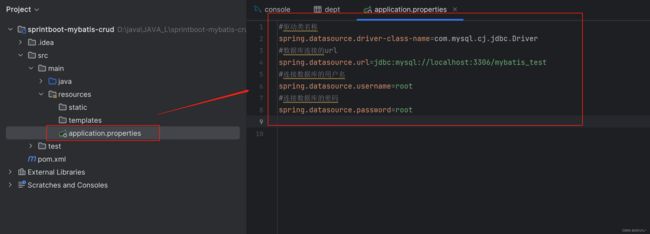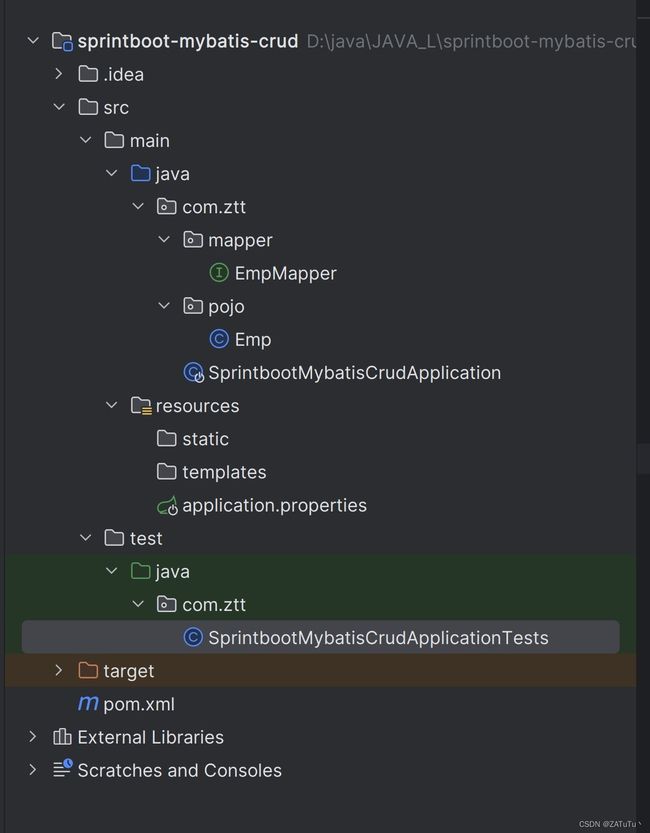SpringBoot-Mybatis 入门(数据库增删改查)
创建SpringBoot-Mybatis项目
创建新项目,注意Type要选择Maven

Spring Boot的版本没啥硬性要求,一般开开发环境
依赖必选MySQL Driver、MyBatis Framework;
选Spring Web是为了辅助未来的web开发;
Lombok是个人开发习惯。
![]()
配置
找到resources下的application.properties,在该文件下配置数据库的四要素(驱动、数据库连接、用户和密码)
#驱动类名称
spring.datasource.driver-class-name=com.mysql.cj.jdbc.Driver
#数据库连接的url //使用的时候记得自己改一下mybatis_test指的是要操控数据库的名称
spring.datasource.url=jdbc:mysql://localhost:3306/mybatis_test
#连接数据库的用户名
spring.datasource.username=root
#连接数据库的密码
spring.datasource.password=root
在这里插入代码片
实现
在com.ztt.pojo包下构建实体类Emp,
因为我们有Lombok所以可以通过@Data(生成Getter和Setter方法)@NoArgsConstructor(无参构造)@AllArgsConstructor(全参构造)。
package com.ztt.pojo;
import lombok.AllArgsConstructor;
import lombok.Data;
import lombok.NoArgsConstructor;
import java.time.LocalDate;
import java.time.LocalDateTime;
@Data
@NoArgsConstructor
@AllArgsConstructor
public class Emp {
private Integer id; //用户ID
private String username; // 用户名
private String password; //密码
private String name; //姓名
private Short gender; // 性别
private String image; // 图像的URL
private Short job; //职位
private LocalDate entrydate; //入职时间
private Integer deptId; // 部门ID
private LocalDateTime createTime; //创建时间
private LocalDateTime updateTime; //更新时间
}
com.ztt.mapper下实现接口方法(interface )。
删除数据
直接在EmpMapper下实现Mybatis的删除数据方法,通过@Mapper自动创建接口的代理对象,并将对象装入IOC容器中,在@Delete中写需要SQL语句,利用#{}作为占位符。
@Mapper //自动创建接口的代理对象,并将对象装入IOC容器中
public interface EmpMapper {
// 删除数据
@Delete("delete from emp where id = #{id}")
public int delete(Integer id);
}
删除方法
这里所有方法都包裹在public interface EmpMapper {},为了方便这里就不写了
@Options用于主键返回,keyProperty = "id"指的是主键返回到那个参数上,未来可以直接通过 emp.id 在java中查看到主键,同理这里也用#{}占位符。
// 新增员工
@Options(useGeneratedKeys = true,keyProperty = "id") //用于主键返回,返回的主键通过keyProperty控制,并将其返回到emp的ID上
@Insert("insert into emp(username,name,gender,image,job,entrydate,dept_id,create_time,update_time)"+
"values (#{username},#{name},#{gender},#{image},#{job},#{entrydate},#{deptId},#{createTime},#{updateTime});")
public void insert(Emp emp);
更新数据
// 更新数据
@Update("update emp set username=#{username},name=#{name},gender=#{gender},image=#{image},job=#{job},entrydate=#{entrydate},dept_id=#{deptId},update_time=#{updateTime} where id = #{id};")
public void update(Emp emp);
查询数据
@Select("select * from emp where id = #{id}")
public Emp getEmpById(Integer id);
这里需要注意,由于数据库中字段名为update_time、dept_id;但是我们上面实现的实体类中名称为updateTime、deptId,上下有不一致的问题。
我们检索到的结果为:emp(id=1, username=jinyong, password=123456, name=金庸, gender=1, image=1.jpg, job=4, entrydate=2000-01-01, deptId=null, createTime=null, updateTime=null),可以看到不匹配的位置都是空的。
为了解决上述问题一共有三种解决办法
1.在SQL语言中起别名,来跟我们的实体类对应,完成映射
@Select("select id,username,password,name,gender,image,job,entrydate,dept_id deptId,create_time createTime,update_time updateTime from emp where id = #{id}")
public Emp getEmpById(Integer id);
2.采用封装映射的办法,利用Mybatis中的Results和Result进行映射定义
@Results({
@Result(column = "dept_id",property = "deptId"),
@Result(column = "update_time",property = "updateTime"),
@Result(column = "create_time",property = "createTime")
})
public Emp getEmpById(Integer id);
- 解决方法3 --开启mybatis的驼峰命名自动映射开关,在application.properties中自动配置
我们转到application.properties添加驼峰映射开关:mybatis.configuration.map-underscore-to-camel-case=true
添加完成后SQL语句查找出来的dept_id就会自动映射成deptId,然后我们再使用上面的方法就可以了。
@Select("select * from emp where id = #{id}")
public Emp getEmpById(Integer id);
列表条件查询
@Select("select * from emp where name like concat('%',#{name},'%') and gender = #{gender} " +
"and entrydate between #{begin} and #{end}" +
" order by update_time desc ;")
public List<Emp> selectList(String name, Short gender, LocalDate begin, LocalDate end);
Mapper文件全部代码
package com.ztt.mapper;
import com.ztt.pojo.Emp;
import org.apache.ibatis.annotations.*;
import java.time.LocalDate;
import java.util.List;
@Mapper //自动创建接口的代理对象,并将对象装入IOC容器中
public interface EmpMapper {
// 删除数据
@Delete("delete from emp where id = #{id}")
public int delete(Integer id);
// 新增员工
@Options(useGeneratedKeys = true,keyProperty = "id") //用于主键返回,返回的主键通过keyProperty控制,并将其返回到emp的ID上
@Insert("insert into emp(username,name,gender,image,job,entrydate,dept_id,create_time,update_time)"+
"values (#{username},#{name},#{gender},#{image},#{job},#{entrydate},#{deptId},#{createTime},#{updateTime});")
public void insert(Emp emp);
// 更新数据
@Update("update emp set username=#{username},name=#{name},gender=#{gender},image=#{image},job=#{job},entrydate=#{entrydate},dept_id=#{deptId},update_time=#{updateTime} where id = #{id};")
public void update(Emp emp);
// 查询数据
// @Select("select * from emp where id = #{id}")
// emp(id=1, username=jinyong, password=123456, name=金庸, gender=1, image=1.jpg, job=4, entrydate=2000-01-01, deptId=null, createTime=null, updateTime=null)
// 解决方法1--起别名
//@Select("select id,username,password,name,gender,image,job,entrydate,dept_id deptId,create_time createTime,update_time updateTime from emp where id = #{id}")
// 解决方法2--封装映射
// @Results({
// @Result(column = "dept_id",property = "deptId"),
// @Result(column = "update_time",property = "updateTime"),
// @Result(column = "create_time",property = "createTime")
// })
// 比较繁琐一般不用
//解决方法3 --开启mybatis的驼峰命名自动映射开关
// 在application.properties中自动配置
@Select("select * from emp where id = #{id}")
public Emp getEmpById(Integer id);
// 列表条件查询
// @Select("select * from emp where name like '%${name}%' and gender = #{gender} " +
// "and entrydate between #{begin} and #{end}" +
// " order by update_time desc ;")
// 在使用过程中仍然要尽量避免使用${name}占位符,可以直接使用SQL的拼接方法
@Select("select * from emp where name like concat('%',#{name},'%') and gender = #{gender} " +
"and entrydate between #{begin} and #{end}" +
" order by update_time desc ;")
public List<Emp> selectList(String name, Short gender, LocalDate begin, LocalDate end);
}
SQL中占位符
一般来说占位符有两种分别是#{...}和${...}。
执行SQL时候,Spring会将#{...}替换为?,从而生成预编译的SQL,会自动设置参数值,一般参数传递建议使用#{...}。
而${...},通常是拼接SQL,直接将参数拼接到SQL语句中,这样做的问题是可能存在注入攻击的风险。
所以我们一般不推荐使用${...}。
注意:列表条件查询,如果涉及到:
@Select("select * from emp where name like '%${name}%' and gender = #{gender} and entrydate between #{begin} and #{end} order by update_time desc ;")这种语句。'%#{name}%'可能会面临#{…}失效的问题。
为应对SQL中字符串的拼接问题,我们一般采用SQL中的concat()拼接来解决问题
例如:上面的拼接我们就可以转换成
@Select("select * from emp where name like concat('%',#{name},'%') and gender = #{gender} and entrydate between #{begin} and #{end} order by update_time desc ;")
测试
测试直接放在测试文件下进行测试即可
package com.ztt;
import com.ztt.mapper.EmpMapper;
import com.ztt.pojo.Emp;
import org.junit.jupiter.api.Test;
import org.springframework.beans.factory.annotation.Autowired;
import org.springframework.boot.test.context.SpringBootTest;
import java.time.LocalDate;
import java.time.LocalDateTime;
import java.util.List;
@SpringBootTest
class SprintbootMybatisCrudApplicationTests {
@Autowired
private EmpMapper empMapper;
@Test
public void testDelete()
{
int delete = empMapper.delete(17);
System.out.println(delete);
}
@Test
public void testInsert()
{
// 构造员工对象
Emp emp = new Emp();
emp.setUsername("Tom1");
emp.setName("汤姆1");
emp.setImage("1.jpg");
emp.setGender((short)1);
emp.setJob((short)1);
emp.setEntrydate(LocalDate.of(2000,1,1));
emp.setCreateTime(LocalDateTime.now());
emp.setUpdateTime(LocalDateTime.now());
emp.setDeptId(1);
empMapper.insert(emp);
System.out.println(emp.getId()); //主键返回接受
}
@Test
public void testUpdate()
{
// 构造员工对象
Emp emp = new Emp();
emp.setId(19);
emp.setUsername("Tom13");
emp.setName("汤姆13");
emp.setImage("2.jpg");
emp.setGender((short)2);
emp.setJob((short)2);
emp.setEntrydate(LocalDate.of(2000,2,2));
emp.setUpdateTime(LocalDateTime.now());
emp.setDeptId(2);
empMapper.update(emp);
}
@Test
public void testSelectEmp()
{
Emp emp =new Emp();
emp = empMapper.getEmpById(1);
System.out.println(emp);
// emp(id=1, username=jinyong, password=123456, name=金庸, gender=1, image=1.jpg, job=4, entrydate=2000-01-01, deptId=null, createTime=null, updateTime=null)
}
@Test
public void testList()
{ List<Emp> emplist = empMapper.selectList("张",(short) 1,LocalDate.of(2010,1,1),LocalDate.of(2020,1,1));
System.out.println(emplist);
}
}
Mybatis的XML配置文件
Mybatis的开发有两种:注解和XML。
XML配置规范
使用Mybatis的注解方式,主要是来完成一些简单的增删改查功能。如果需要实现复杂的SQL功能,建议使用XML来配置映射语句,也就是将SQL语句写在XML配置文件中。
在Mybatis中使用XML映射文件方式开发,需要符合一定的规范:
-
XML映射文件的名称与Mapper接口名称一致,并且将XML映射文件和Mapper接口放置在相同包下(同包同名)
-
XML映射文件的namespace属性为Mapper接口全限定名一致
-
XML映射文件中sql语句的id与Mapper接口中的方法名一致,并保持返回类型一致。
XML创建
在resources下新建com/ztt/mapper包(这个要与上面的接口包名对应),在这个包下新建EmpMapper.xml文件,这个文件名要与EmpMapper对应。

这一段不用记住,直接去官网下载就行或复制就行。
<?xml version="1.0" encoding="UTF-8" ?>
<!DOCTYPE mapper
PUBLIC "-//mybatis.org//DTD Mapper 3.0//EN"
"https://mybatis.org/dtd/mybatis-3-mapper.dtd">
<mapper namespace="">
</mapper>
具体的Mybatis配置放在下面,被或
XML映射文件的namespace属性为Mapper接口全限定名。
XML映射文件中sql语句的id与Mapper接口中的方法名一致,并保持返回类型一致。
resultType为返回类型,
<?xml version="1.0" encoding="UTF-8"?>
<!DOCTYPE mapper PUBLIC "-//mybatis.org//DTD Mapper 3.0//EN"
"http://mybatis.org/dtd/mybatis-3-mapper.dtd">
<mapper namespace="com.ztt.mapper.EmpMapper">
<select id="selectListByXML" resultType="com.ztt.pojo.Emp">
select *
from emp
<where>
<if test="name != null">
name like concat('%', #{name}, '%')
</if>
<if test="gender !=null">
and gender = #{gender}
</if>
<if test="begin!=null and end!=null">
and entrydate between #{begin} and #{end}
</if>
</where>
order by update_time desc;
</select>
<delete id="deleteByXML">
delete from emp where id = #{id}
</delete>
<insert id="insertByXML">
insert into emp(username,name,gender,image,job,entrydate,dept_id,create_time,update_time)
values (#{username},#{name},#{gender},#{image},#{job},#{entrydate},#{deptId},#{createTime},#{updateTime});
</insert>
<update id="updateByXML">
update emp set username=#{username},name=#{name},gender=#{gender},image=#{image},job=#{job},entrydate=#{entrydate},dept_id=#{deptId},update_time=#{updateTime} where id = #{id};
</update>
<select id="getEmpByIdByXML" resultType="com.ztt.pojo.Emp">
select * from emp where id = #{id}
</select>
</mapper>

